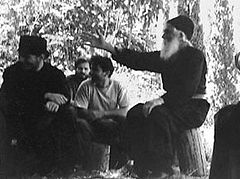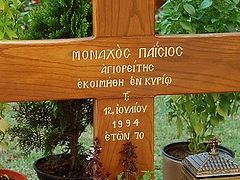 From the Lives of the Saints we know many examples of saints communicating with wild nature. Sts. Sergius of Radonezh and Seraphim of Sarov were friends with bears, and Gerasim of Jordan befriended a lion. There was a saint who even tamed a crocodile—St. Hellius of Egypt.
From the Lives of the Saints we know many examples of saints communicating with wild nature. Sts. Sergius of Radonezh and Seraphim of Sarov were friends with bears, and Gerasim of Jordan befriended a lion. There was a saint who even tamed a crocodile—St. Hellius of Egypt.
The Church sees in this phenomenon the return of man to the original state of Adam, when man was the master of Divine Creation, as stated in Genesis:
And God said, Let us make man in our image, after our likeness: and let them have dominion over the fish of the sea, and over the fowl of the air, and over the cattle, and over all the earth, and over every creeping thing that creepeth upon the earth (Gen. 1:26).
The famous Athonite ascetic, St. Paisios the Hagiorite, used to speak about the correlation between the spiritual state of man and the natural world:
“In Paradise, the animals sensed the fragrance of grace and served Adam. Since the fall, nature has been suffering together with man. Look at the poor hare—it always has a scared look. Its heart is pounding anxiously—rat-a-tat-tat. The poor creature does not sleep at all! How much this tiny, innocent mammal suffers because of our sins! However, when a person returns to the state in which he was before the fall, animals again approach him without fear.”1
St. Paisios himself was surrounded by many animals on Mt. Athos.
“In my kaliva there are jackals, hares, weasels, turtles, lizards, snakes and birds,” the elder wrote in one of his letters. “They are all filled with love, and I draw love from them, and together we praise, bless and worship God.”2
Jackals touched the venerable man’s heart by crying like children when they were hungry, and he often fed them by throwing something to eat out of the window. One day Fr. Paisios with the help of a jackal brought to reason a young man who had a habit of blaspheming. That fellow was helping a local lumberjack on Mt. Athos and he blasphemed the Heavens whenever he had difficulties in his work. The lumberjack, fearing for the young man under his patronage, that he might be expelled from the Holy Mountain (and he was an orphan), brought him to the elder. Fr. Paisios kindly addressed the young man. “My dear, why do you blaspheme? Don’t you believe in God?” The answer was sharply negative. Then the saint said, “Well, I’ll have to call my jackal, and we’ll see how you don’t believe.” As if out of nowhere a large gray wolf-like animal appeared and headed towards the young man. The guy screamed out of fright: “My Panagia, my Panagia!” “Oh, that’s how you don’t believe!” the elder exclaimed and waved the animal away. Thenceforth the would-be atheist stopped blaspheming.
The man of God pitied the animals that were hunted:
“These poor creatures sacrifice themselves for us! And this despite the fact that we are to blame for their suffering. After all, since the fall of our ancestors nature has been groaning with man, suffering with him. How horrible it is! Look at how wild animals that are injured by hunters suffer! Crippled, with broken legs, they cannot escape from large predators that torment and devour them. And at the same time, the unfortunate ones do not receive the slightest reward!”3
Sometimes he caught hares and marked their fluffy heads with a red cross, after which he let them go with a blessing. Hunters didn’t shoot them. He also prayed for wild boars. Once, when the elder was on his way to Stavronikita Monastery, he saw a boar at which a hunter was aiming a gun. Fr. Paisios made the sign of the cross over the animal and prayed that not a single bullet would hit it. From that day onwards the boar greeted the monk with a grateful grunt as he went to his monastery.
Hieromonk Christodulos (Kapetas) left the following memories of St. Paisios’s communication with animals:
“We had heard concerning Father Paisios that he talked to mammals and birds and took snakes into his hands, but I personally did not believe it and took it as worldly rumors. In early July 1971, my spiritual brother Konstantinos Litras and I visited Elder Paisios in the Cell of the Holy Cross. We arrived in the morning, about half past nine, and the elder received us in his ‘open–air pilgrim hostel’—that is, under an olive tree. He brought us treats: a dried fig and two or three hazelnuts each, set down a glass of water, and began to speak about various spiritual subjects.
“In the place where the elder’s cell is situated, many nightingales and other birds would gather, chirp and sing incessantly. They interfered with our conversation, and the elder said: ‘Make a stop (note that he did not say, “Be silent!”), blessed birds! You see that I am talking to people! When I’ve finished, then you start again.’ At the same moment, the birds stopped singing, while remaining in their places.
“The incident made such an impression on us that it became impossible to maintain the conversation anymore. It was also a secret answer to me personally—an answer to the doubts I had had about Elder Paisios.”4
St. Paisios communicated not only with birds, but also with snakes. The elder pitied them more than other animals:
“Poor creatures!” he would exclaim. “They sleep in burrows the whole winter, and in the spring, once they stick their little heads out, people come and kill them. No one seems to love them. However, if you show them at least a little love, they will understand it and will not harm you.”5
The elder’s words about his meeting with a viper have been preserved:
“Wild animals feel when you love them and they approach you without fear. However, I thought that this did not apply to snakes. Later I became convinced that it was also the case with them. One day a viper crawled up to me, stuck out its tongue and hissed. It had overheated in the broiling heat and was asking for a drink. I poured some water into a jar for it, and it drank it. The viper is like a goat compared to a sheep among other snakes.”6
The area around the Cell of the Holy Cross, where the ascetic lived, was teeming with snakes, which is why they appeared so often when the elder spoke with visitors. He would wave them away with a free gesture: “Don’t you see that I have guests? Go somewhere else.” Astonished pilgrims would see how the snakes obeyed him.
One day, when the saint was talking to someone in the courtyard, he suddenly interrupted the conversation and said, “Okay, come in, come in!” And the visitor saw a large snake crawling right towards him. Terrified, he rushed into the monk’s cell and through a small window in the door saw the snake bow to the monk. Startled by this, he cautiously returned to the courtyard. Fr. Paisios said, “Bow to him too!” The snake bowed to the guest, and the elder sent it back.
Pavle Rak, a Serbian theologian and writer, has even more striking memories of Fr. Paisios. One narrow-minded journalist came and asked the elder, “Is there a God?” Elder Paisios immediately called for someone, saying, “Jeremiah, come here.” A snake appeared from some crack, and the elder asked it, “Jeremiah, he is wondering if there is a God.” Jeremiah, to the journalist’s amazement, replied, “There is”, and crawled away.7
Do you remember that in the famous Harry Potter franchise the main character could talk to snakes? But, with all our possible liking for this book, it is just artistic fiction. If we really want to learn to live in harmony with wild nature, learn how to communicate with it, we should return to the state in which man was before fall, walking the path of holiness and love, as did St. Paisios the Hagiorite.




